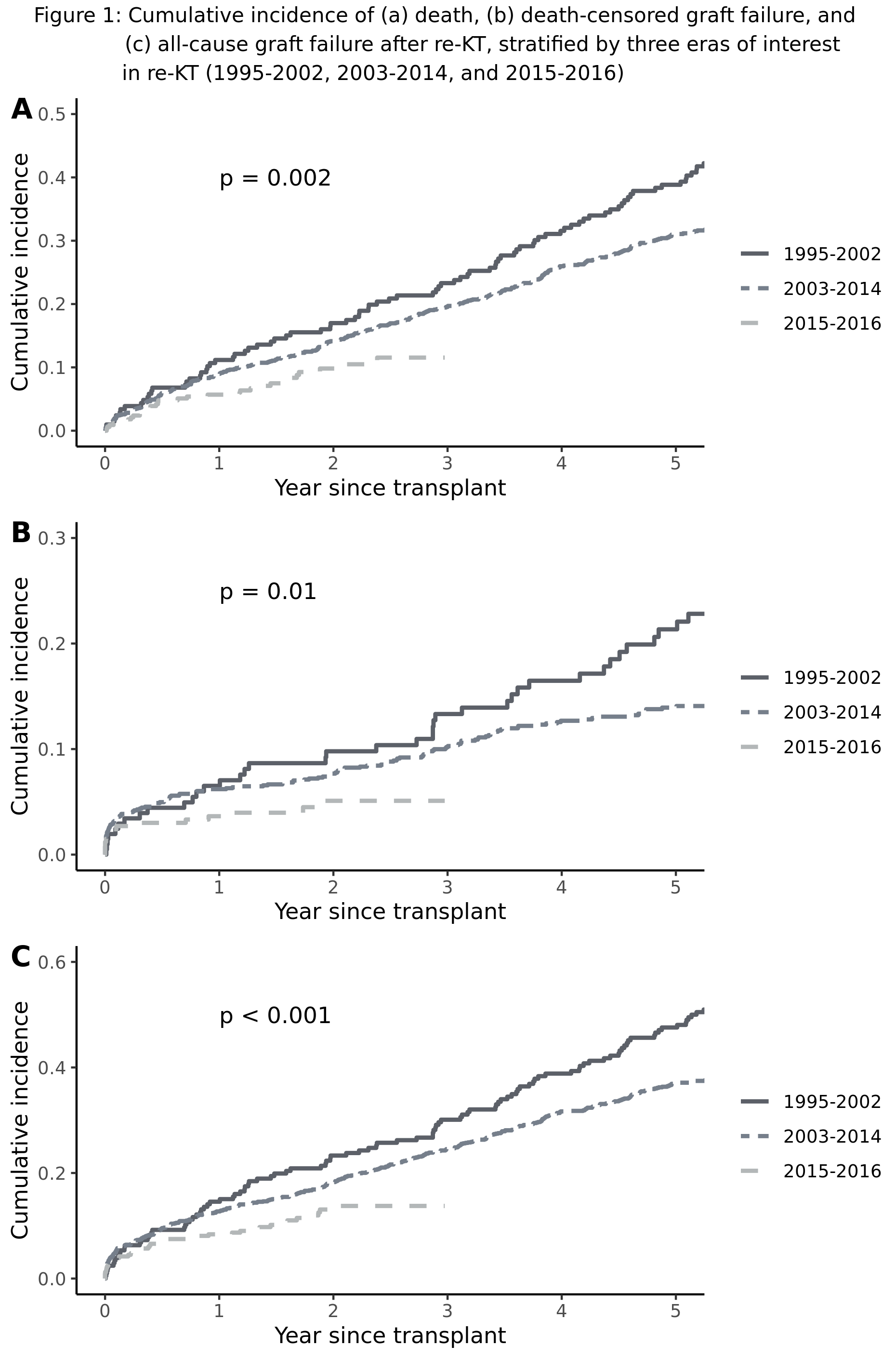Evolving Trends in Risk Profiles and Outcomes in Older Adults Undergoing Kidney Re-Transplantation
S. Sandal1, J. Ahn2, M. Cantarovich1, N. Chu2, D. Segev2, M. McAdams DeMarco2
1McGill University, Montreal, QC, Canada, 2Johns Hopkins University, Baltimore, MD
Meeting: 2021 American Transplant Congress
Abstract number: 326
Keywords: Elderly patients, Graft failure, Outcome, Retransplantation
Topic: Clinical Science » Kidney » Kidney Psychosocial
Session Information
Session Name: Kidney Psychosocial
Session Type: Rapid Fire Oral Abstract
Date: Tuesday, June 8, 2021
Session Time: 4:30pm-5:30pm
 Presentation Time: 4:35pm-4:40pm
Presentation Time: 4:35pm-4:40pm
Location: Virtual
*Purpose: The half-life of a kidney transplant (KT) is 8-12 years, and a significant proportion of patients end up with graft loss at age ≥65 years. Indeed, graft loss is one of the leading causes of kidney failure. While there has been a significant increase in older adults receiving their first KT over the past three decades, it is not known if there were parallel trends in re-KT. Thus, we aimed to characterize the trends, changing landscape, and outcomes of re-KTs in older adults.
*Methods: Among the 44,149 older kidney-only recipients (1995-2016) in the Scientific Registry of Transplant Recipients, we identified 1,743 who were undergoing re-KT. We analyzed trends by eras (1995-2002, 2003-2014 and 2015-2016) and outcomes (death-censored graft failure (DCGF), all-cause graft failure (ACGF), death) using Kaplan-Meier estimators.
*Results: Among all older patient undergoing KT, only 3.9% were re-KT. However, over time this proportion increased significantly (1995-2002: 2.7%, 2003-2014: 4.2%, 2015-2016: 5.7%, p<0.001). The median age at re-KT (1995-2002: 67, 2003-2014: 68, 2015-2016: 68, p=0.04) and the lifetime of the first transplant, i.e. duration of exposure to immunosuppression (1995-2002: 2.7, 2003-2014: 6.5, 2015-2016: 8.6 years, p<0.001) have also increased significantly. Older re-KT patients are more likely to have a PRA of 80-100% (1995-2002: 22.0%, 2003-2014: 32.7%, 2015-2016: 48.7%, p<0.001), spend longer time on dialysis after first graft failure (1995-2002: 1.4 years, 2003-2014: 1.5 years, 2015-2016: 2.2 years, p=0.003), be living with assistance (1995-2002: 9.0%, 2003-2014: 12.6%, 2015-2016: 24.8%, p<0.001), undergo donations after circulatory death (1995-2002: 1.1%, 13.4%, 19.5%, p<0.001), and have an older donor (1995-2002: 40 years, 2003-2014: 43 years, 2015-2016: 43.5 years, p=0.04). Despite this, the 3- and 5-year cumulative incidence of death, DCGF and ACGF have decreased significantly over time (Figure 1).
*Conclusions: In older adults with re-KT, the 3-year cumulative incidence for death, DCGF, and ACGF has decreased by >50% in the past two decades despite a widening risk profile. Yet, they represent a small fraction of the total KTs performed. It is encouraging to see that this proportion has doubled over the past two decades, however, there are likely significant barriers to re-KT in older adults. Factors associated with these trends need to be better understood to inform clinical practice and policy.
To cite this abstract in AMA style:
Sandal S, Ahn J, Cantarovich M, Chu N, Segev D, DeMarco MMcAdams. Evolving Trends in Risk Profiles and Outcomes in Older Adults Undergoing Kidney Re-Transplantation [abstract]. Am J Transplant. 2021; 21 (suppl 3). https://atcmeetingabstracts.com/abstract/evolving-trends-in-risk-profiles-and-outcomes-in-older-adults-undergoing-kidney-re-transplantation/. Accessed December 18, 2025.« Back to 2021 American Transplant Congress

